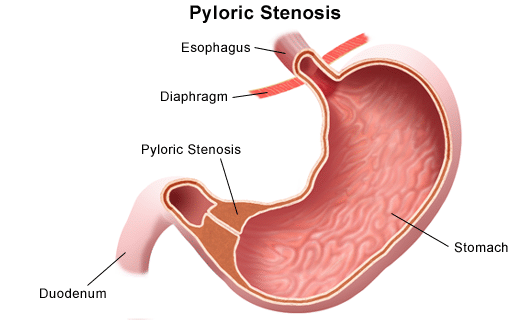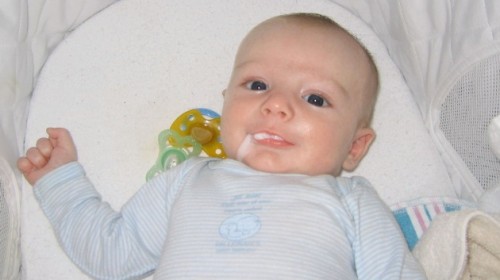Pyeloric Stenosis and Bottle Feeding
Pyloric Stenosis (PS) is the most common condition requiring surgery in infants under 4 months and we’ve known how to diagnose it and even treat it for a long time – at least since around 1911. Before that time about four in every thousand newborn babies died within a few weeks from malnutrition and dehydration because they weren’t able to eat and keep anything down.
Even today, in Denmark (the location of a new study about bottle feeding I’m about to tell you of) slightly under two per 1000 live births require surgery for the condition. They seem to do fine for a few days then begin spitting up pretty much every feeding.
The pyloric (outlet) end of the stomach, for some reason begins to hypertrophy to the point that it completely blocks any food from exiting the stomach.
As it progresses the “spitting” becomes projectile. I mean leaping over every towel or bib, bouncing off your shoulder and hitting the floor. Obviously symptoms of dehydration and malnutrition rapidly ensue. There are also obvious physical examination signs observable by a Pediatrician as well as patterns on x-rays, ultrasounds and blood tests.
What is not readily available is a clear understanding of what is causing this malady. Statistics show that it is more common when there is a family history of PS – so is it genetic? It’s most common in boys – so is it sex-linked?
It’s also more common in first-borns – huh? Is it biblical?
The problem with that is: it doesn’t occur for a few days and is worse in some than in others – so, is it environmental?
All of these statistics I’ve mentioned were discovered by difficult attempts to study a 2-4 in a thousand condition. It takes a LOT of work. [Just like my attempts to find a photo of projectile vomiting on the internet – there isn’t even one single shot.]
Pyeloric Stenosis vs Bottle Feeding
 One of the recent studies tried to follow up a confusing observation in Denmark during the 1990’s. It was observed that the prevalence of breast-feeding substantially increased in the country during that time (bottle feeding decreased) AND the incidence of PS dropped when it happened. Go figure. And, what on earth does that mean?
One of the recent studies tried to follow up a confusing observation in Denmark during the 1990’s. It was observed that the prevalence of breast-feeding substantially increased in the country during that time (bottle feeding decreased) AND the incidence of PS dropped when it happened. Go figure. And, what on earth does that mean?
Additionally, and quite fortuitously, the researchers had access to the massive amount of data from the Danish National Birth Cohort, which enrolled 101,042 pregnancies in 91,827 Danish women between 1996 and 2002. Trained interviewers made contact with each woman by telephone and asked a multitude of questions, including relating to breast or bottle feeding with formula.
They then matched all these data with surgical codes to match feeding practices with pyloric stenosis occurrence so they could report about it in the medical journal. What did they find?
Doctor Krough (Copenhagen Denmark) stated: “In this large cohort study, we found that infants who were bottle fed had a 4.6-fold increased risk of developing PS compared with infants who were not bottle fed, even after adjustment for other known risk factors and possible confounders.”
There were 101,042 pregnancies, 91,827 women, 70,148 completed all four interviews for inclusion and 65 infants who had surgery for PS all followed up for the first four months of life. By any current standards, that’s a huge study and a lot of work.
Additionally, it didn’t seem to matter whether the infants were also breast fed either a lot or a little. An increased risk was seen among those who had both breast and bottle feeding, those who were formerly breast-fed, and those who were never breast-fed.
A complete conjecture might be that infant formula contains higher levels of whey and casein proteins than breast milk, and therefore may be more difficult for infants to digest. But, who knows?
We all must understand however that this was NOT a study that was designed specifically to research this topic, it was an after-the-fact analysis of a study done to collect data for another purpose – a “meta analysis.” That means it is meaningful but hardly definitive.
Even the authors acknowledge that; but, their findings do need to be reported for others to use AND it needs to be acknowledged that their results DO at least strengthen the several other, already existing evidences which support breast-feeding for the first four to six months.
This study does add a little twist in that it supports making it exclusive breast feeding without any exposure to artificial milk.
[Pediatrics, Sep 3 2012]
Study Highlights – Pyeloric Stenosis and Bottle Feeding
◾Researchers examined records from the Danish National Birth Cohort, which enrolled 101,042 pregnancies in 91,827 Danish women between 1996 and 2002.
◾Twice during pregnancy (weeks 12 and 30) and twice after delivery (6 and 18 months), women were interviewed by telephone for exposure histories.
◾For this study, women were included if they had live singleton pregnancies and if they answered questions at the 6-month postdelivery interview.
◾70,148 infants fulfilled inclusion criteria.
◾Information on feeding practice was obtained at the 6-month interview.
◾Mothers were asked about whether they were currently breast-feeding, how long they had fully breast-fed their infants, and when they stopped breast-feeding.
◾All answers were translated into days of feeding from birth.
◾Mothers who did not report full breast-feeding among infants younger than 4 months were assumed to have bottle-fed their infants.
◾Bottle-fed infants were assumed to have been consuming artificial milk.
◾Information on PS status was derived from the Danish National Patient Register.
◾Infants with PS were defined as those who had pyloromyotomy determined by surgery codes.
◾65 cases of PS were included in the study.
◾Covariates included mothers’ socioeconomic status, smoking habits, infant sex, birth order, and other demographic data.
◾The cohort of 70,148 infants was followed up for 4 months, during which 65 infants had PS surgery, for an incidence of 0.1%.
◾Among the infants with PS, 91% were boys.
◾Median age at diagnosis of PS was 35 days, and 95% were diagnosed between ages 13 and 69 days.
◾29 of 65 infants were bottle-fed before the diagnosis of PS and surgery.
◾Among infants who were ever breast-fed, median age at first exposure to bottle-feeding was 91 days for infants with PS and 12 days for infants without PS.
◾Follow-up included 4781 person-years for infants who were bottle-fed and 18,635 person-years for infants who were not bottle-fed.
◾The HR for PS for infants who were bottle-fed vs those who were not bottle-fed was 4.62.
◾Among bottle-fed infants, there was no significant difference in risk between those who were both breast-fed and bottle-fed (HR, 3.36) and those who were never breast-fed (HR, 6.32).
◾PS incidence did not vary by age of exposure to bottle-feeding either.
◾There was also no variation in the risk for PS according to attained age of the infant (< 30 days vs ≥ 30 days) or sex (HR, 3.91 for boys; HR, 30.09 for girls).
◾Among bottle-fed infants, PS developed in 0.31% within 4 months vs 0.05% among those not bottle-fed.
◾The authors concluded that feeding practice — in particular, bottle-feeding — was associated with an increased risk for PS among infants and that this risk was seen among those who were both breast-fed and bottle-fed, those who were formerly breast-fed, and those who were never breast-fed.
◾They also concluded that the findings strengthened the evidence supporting the need to encourage breast-feeding.
◾Bottle-feeding vs no bottle-feeding among infants is associated with a higher risk for PS by age 4 months.
◾The increased risk for PS seen with bottle-feeding is independent of the sex of the infant, the presence or absence of breast-feeding, and the time of exposure to bottle-feeding.
Advertisement by Google
(sorry, only few pages have ads)

